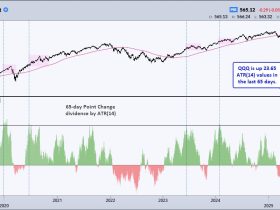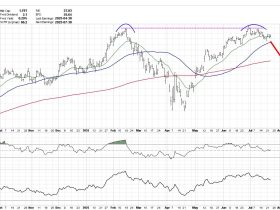As the year ends, it’s time to think about your New Year’s resolutions. But how can you make them last longer than a few weeks? Here’s one approach traders and investors can try.
The ball has dropped, the champagne has popped, and you’ve finally got Auld Lang Syne out of your system. You’re ready to move on to the next year—schedule your juice cleanses, sign up with a personal trainer, and buy a new pair of running shoes. This year, you’re determined to stick to your resolutions beyond one month. But really, what are the odds of that happening? Well, you know yourself better than anyone.
If you’re anything like the average person, you’ll break all your resolutions in less than a week. So, instead of being hard on yourself, try a different approach this year. Consider applying your top 5 resolutions to your investment portfolio. Here are 5 to get you started.
Resolution #1: Give Your Portfolio Adequate Exercise
Like you, your portfolio needs a regular workout. If you let your portfolio become sedentary, some of the assets could become sluggish. So, from time to time, identify the assets that are sitting there not doing much, and think of ways you could get them out of their slump. You may not want to sell those assets because they’re still doing your portfolio some good. So how can you add some sizzle to those investments?
Well, try shaking things up a bit by learning about different strategies you could apply in order to squeeze a little more out of those slackers. Have you ever thought of strategies like covered calls or cash-secured puts? How about pairs trading? The new year may be a good time to learn about different strategies that could make your portfolio more active.
Resolution #2: Feed Your Portfolio a Healthy Diet
Just like a healthy diet has recommended portions of carbs, protein, and fat, your portfolio should also contain a healthy balance of different asset classes or sectors. You’ve heard the adage, “don’t put all your eggs in one basket.” You don’t want to have one stock, sector, or asset class overweight your portfolio.
For example, you could allocate your investments between equities, bonds, commodities, and currencies. Within each of these classes are subclasses. Equities can be divided into different sectors or asset classes. Bonds could be divided between government and corporate. Commodities could mean gold, crude oil, or corn. You get the idea.
Find a healthy balance that diversifies your portfolio, meets your investment objective, and maintains your risk tolerance level. Then maintain that balance, because, as you know too well, things change.
Resolution #3: Limit Your Portfolio’s Fat Content
Everyone’s guilty of reaching for the gooey gastronomical delights and eating the entire box. The same desire extends to even the best traders and investors. When the price of a few stocks keep going up and up and up for no good reason—think meme stocks—it’s tempting to bend your trading rules. Everyone else is doing it, so why not you? So you plump up your portfolio with the stocks everyone’s chasing.
Then, after a while, your portfolio’s gut, er, health starts to suffer.
The problem: If your portfolio ends up being overweight with those few stocks, your portfolio’s lifespan may reduce. Resist the temptations the stock market throws at you. If you still end up reaching for these high-fliers, know that it’s probably a short-term play. Don’t be lured by visions of long-term benefits.
Resolution #4: Don’t Fall In Love With a Stock
Hopefully, you invested in an asset to make a positive return from your investment. But sometimes it’s easy to fall in love with a stock because the price keeps going higher and higher. You add more of that stock to your portfolio because your “darling” stock is going to give you even greater returns. But the higher prices go could mean that they have further to fall. And if that stock ends up falling lower and lower, you’ll be left heartbroken.
If the asset is no longer meeting your investment objective, there’s no reason to hold it close to your heart. Remember, all big losses start out as small ones. Be prepared to let go of the loser.
Resolution #5: Handle Your Portfolio With Care
Every asset in your portfolio is fragile. Even the least risky investment carries a risk that needs to be carefully managed. Proper risk management is what makes an investor or trader shine. So, how do you prevent your portfolio from experiencing catastrophic losses?
Think about how much of a loss you’re comfortable taking. That’s easier said than done—it’s a fine balance between art and science. Maybe you’re willing to lose 20% on each trade, or you’re willing to lose that much from your entire portfolio at any given time. Maybe your threshold is lower. Only you can decide how much you’re willing to lose on a trade. But remember, too low and you may end up with too many losing positions and not enough winners to make it worth your money. And if your threshold level is too high, you may end up with a drawdown that’ll wipe out your hard-earned returns.
Managing risks is pretty important for investors and traders but is a topic many don’t think about. Treat every asset in your portfolio like a rare collectible. Always think of what could go wrong and how you can protect it by implementing stop orders, thinking about the size of your positions, and diversifying your portfolio adequately.
Sticking To Your New Year’s Resolutions
Just like your personal resolutions, your trading resolutions also require discipline. Set up your ChartLists so they reflect your entire portfolio. After a few months, assess how you’re doing. If you find yourself breaking your rules—slackers in your portfolio, overweight in one area, falling in love with a stock—it may be time to pause, reassess, and reset. Rinse and repeat at regular intervals. Last, but not least, be ready to take on the market, no matter what it throws at you.
Here’s to a healthy and prosperous 2023!
Jayanthi Gopalakrishnan
Director, Site Content
StockCharts.com
Disclaimer: This blog is for educational purposes only and should not be construed as financial advice. The ideas and strategies should never be used without first assessing your own personal and financial situation, or without consulting a financial professional.







